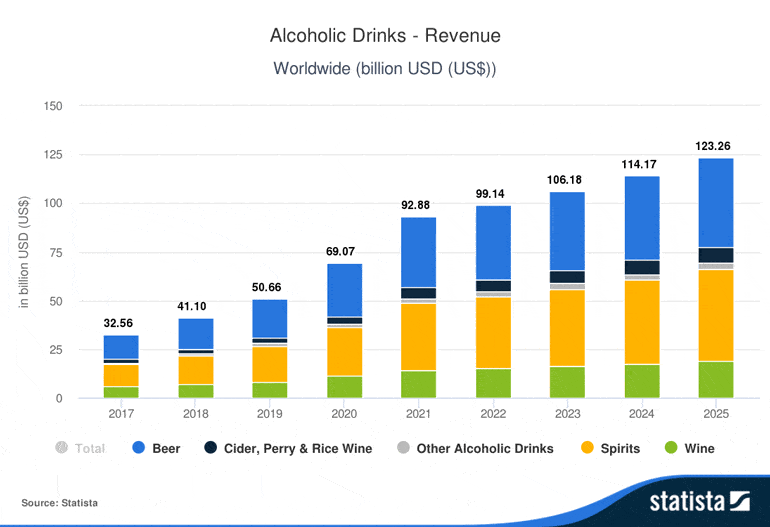When it comes to exploiting the potential of digital and online sales, food and beverage have found their sweet spot. With more online supermarkets entering the market and gaining success, it seems only natural that wineries will follow suit. So vintners need to up their game if they hope to survive, let alone succeed. If you omit critical technology from your site, it is a mistake that will be exploited.
According to the Wine Intelligence Wine E-commerce report, wine ecommerce is expected to grow by 7.7% each year. Across the 13 largest markets, four out of every ten consumers buy wine online. A quarter of respondents said they did not make such online purchases but would think about it.
This article is about why wine is such a popular direct-to-consumer trend, how to overcome some industry’s restrictions like compliance and taxation, and what ecommerce platform to choose for digitising the wine business (plus, a success story for vintners that have already gone online and benefited from it).
The 4 most common challenges in wine ecommerce
Given significant obstacles on the way to success, it is not surprising that companies in the wine industry are implementing wine ecommerce quite slowly. To cut this timeline, let’s first examine the challenges setting these enterprises back.
Poor search & thin content don’t promote sales
When customers visit your website, they should not have to know what to look for. This is a fatal mistake and causes you to lose not only their lifetime customer value but a denigration of the brand in the eyes of your existing customers while offering the same individuals on a plate to your competitors. A simple CRO tool on your site, which offers products pertinent to that individual when they visit is all it needs. This article on the top CRO Optimisation tools by Salesfire might be useful.
Pre-loaded information, including reviews, ratings, drinking dates and other non-standard categorisations, lessens the administrative burden of regularly updating and renewing content. Product definitions and rich information can improve search engine results, especially if content changes alongside products in your webshop.
Producer profiles, personal comments, professional recommendations, drinking tips, bottle shots, label photographs, and product tags also enhance the user experience and support purchasing decisions.

All-eggs-in-one-basket vs omnichannel
The online wine business should be a part of a larger channel strategy. Consolidating all operations into a single system allows you to meet the demands of any sales or marketing channels, and guarantee that your stock level is accurate on every page and at all times.
Due to the importance of connections and expertise in this market, wine sellers almost always use many channels, including online, over the phone or via email. You can decide which wine to sell via which channel, and differentiate pricing per channel to manage margin.
Stock management and fulfilment flexibility
Wine warehouses, shipments and movements, purchases and sales orders are all handled by a business management system. So mastering inventory will ensure precise and current positioning of wines being sold on your eCommerce website.
For the real-time updating of all stock positions, a single point of control is necessary so that it is clear which wines are immediately deliverable and which will be shipped at a later date. The characteristics of the stock might vary depending on the types you are selling.
The sale of wines is complicated by delivery options, associated fees and various taxes. The most striking example is working in different jurisdictions. For instance, state-by-state differences in alcohol laws and regulations in the USA restrict the transportation of wine to consumers and exacerbate logistical difficulties.
With these regulatory restrictions, additional factors like temperature control specifications, and the rising demand for next-day and same-day delivery, managing order fulfilment online becomes even more challenging. Due to the requirement for ID verification, the last mile of delivery is a particularly difficult barrier for businesses across all sectors.
Customer engagement & retention
Building trust with your clients and maintaining the quality of your offering over time are additional factors that contribute to a successful eCommerce business.
Beyond simple cross-selling possibilities, more complex winery sales solutions offer insights into the preferences of your consumers to boost sales and conversions. By suggesting other products, they offer an online shopping experience comparable to that of a physical store.
Your customers will expect to see precise information, including their favourites and wish lists, payment methods, and the wines they are currently storing in addition to their history of online and offline purchases.
Recognizing the role of customer relationship management, you should also integrate your system with cellar management. This covers the wines your customers store, and some retailers extend use to home cellar management to give a 360° view of collections.
Predictive AI personalisation 20x higher ROI
The truth of any successful wine merchant is the lack of time and extremely tight margins before they have to even begin to consider their email marketing. Traditional solutions require dedicating time – ideally on a set time regular basis, to segment and carve up your database of consumers into appropriate segments to target the right offers to the right people.
In fairness, our experience when talking to wine merchants is of a collection of databases, previously dedicated to segments in anticipation of a white preference, or for that matter, red, new world, champagne, fine wine etc. But there is now a sophisticated alternative, originally designed specifically to the wine industry called predictive personalisation software (PPS).
PPS software once installed uses an AI algorithm to watch everything each consumer buys, and more importantly what they look at too, together with all the sequences involved between those two, to calculate what each consumer is most likely to buy next. Then several times each month, without you needing to be involved whatsoever, it takes all those products pertinent to that individual, loads them into an email and delivers the perfect selection to every individual on your database.
Remember that for every visit respect tastes change, especially with seasons and age. No human can keep pace with all the nuances and whims that each dictates. The results verified by McKinsey and Statista and phenomenal. They quantify that, the average ROI is 1500%, and that often 20x (twenty times) greater returns are achieved in comparison to every other form of marketing you do, combined. That’s why it’s critical to have, and will define your success over the next decade.
Because it is digital AI, no human being is involved at all, at any time, it is autonomous. It runs in the background for vintners, and vineyard owners alike. Consider your customers, instead of offering them a cluster of reds because that’s the group you have collated them into, you can offer exactly the Bordeaux, vineyard and year they prefer, each consumer offers their taste!
The effect is that your average basket size (AOV) goes up, customer lifetime value (CLV) goes up, ROI up, and profits up, it’s a no-brainer. This level of tech is no longer the exclusive privilege of enterprise retailers that can afford it, it’s so affordable everyone now has access.
It’s a plugin so the most simple software to install. As far as knowing how to use it, you don’t need to as it does everything for you. There’s no set-up required, no training, or user licenses. Just plug and play.
More great articles for the wine trade here: Wines, Beers and Sprits.





